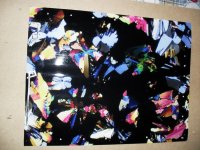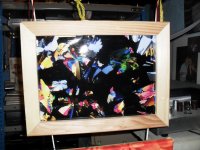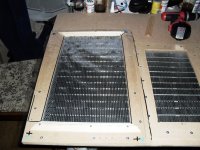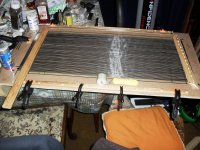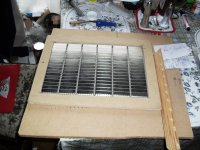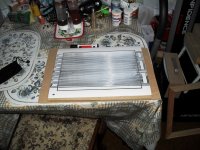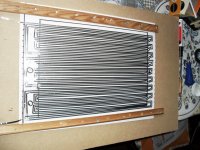I also found out that using a thicker diaphragm is better as the thinner mylar made very funny noises at certain frequencies, and if you shook the mylar on its own in your hand it made a very loud and high frequency noise, so I stopped using mylar of any thickness! When I used a print as a diaphragm, I used double sided tape to stick to the frame as the print was more solid and firm unlike plastic film which is very fidgety in comparison. When I use polythene, I use a picture material, astragal and use screws to fasten in position. Probably would be better to use a moveable mechanism to tighten diaphragm.I use 90 um polythene as my diaphragm material. By not using resistors for the impedance and using the epsilon type layout they are not needed. So all the power is used to drive the music.
If we only concentrate on the bare membrane/diaphragm as the one I made have its own intrinsic resonances regardless of coil material or pattern and magnetic structure.

The Icarex weighs 25 gram per square meter, the membrane above is then a mere 14 grams.
You would then advocate a heavier diaphragm: "perforated sheet magnets diaphragm on thicker polyethylene"?
Another thing is the suspension/surround part of the membrane. In my case it consists of the same material, a 100 mm perimeter outside the active area.
Perhaps the surround should be made of another material?
Don't like the creases, that's why using a print for the diaphragm is a good idea, you don't get any creases!
Don't like the creases, that's why using a print for the diaphragm is a good idea, you don't get any creases!
What kind of material is "a print for the diaphragm"?
I consider my construction safe. It has also the least foot print.If you are still using steel bars for your magnet support, I would use steel bars the same width as the magnets, makes a safer arrangement if you drop or knock the finished article as neos are quite good at jumping. As I found out to my cost before, twice.! Hell of a job to separate
I´m only using one membrane. Perhaps you are referring to the push-pull arrangement? That is needed to get a linear field while the membrane is moving across the gap.I would instead of using 2 diaphragms only use one and put the other neos with the others, probably why it is insensitive. I have tried myself using the 2 diaphragm method not really worth the effort!! I always use my neos touching easier and more sensitive
Yes, that´s definitely my experience as well.I also found out that using a thicker diaphragm is better as the thinner mylar made very funny noises at certain frequencies, and if you shook the mylar on its own in your hand it made a very loud and high frequency noise, so I stopped using mylar of any thickness!
When I used a print as a diaphragm, I used double sided tape to stick to the frame as the print was more solid and firm unlike plastic film which is very fidgety in comparison. When I use polythene, I use a picture material, astragal and use screws to fasten in position. Probably would be better to use a moveable mechanism to tighten diaphragm.I use 90 um polythene as my diaphragm material. By not using resistors for the impedance and using the epsilon type layout they are not needed. So all the power is used to drive the music.
Any ideas on this moveable mechanism?
What is this Astragal material?
So you are currently using 90 um polythene? Can you provide me with a link?
What kind of material is "a print for the diaphragm"?
It's when you order a print using one of your photos, it's printed on shiny paper quite thick so it looks like a shiny picture, the tape goes on the inside so you see the picture and you can frame it, hang it on the wall just like a picture, good disguise if you have to hide your speakers!.Made a couple myself sound quite good, and look good too.
Attachments
I have been working with magnetostatic planars too.
I usualy tuned them to 40-50 Hz.I used PVD for many planars.It is "softer" strechable,but you can´t tune a wide membrame to higer resonanses.
I wanted to try to tune to 100-200 Hz, so I used mylar.
It sounded as you explain. Wrey high Q .A Ecco like sound.
Try to slack the membrame,and with your large "gap I think you should use a stif plate and a sourround of texture or rubber.
Can you test each coil to se if it is "fased" right?
Bernt
Bernt
I usualy tuned them to 40-50 Hz.I used PVD for many planars.It is "softer" strechable,but you can´t tune a wide membrame to higer resonanses.
I wanted to try to tune to 100-200 Hz, so I used mylar.
It sounded as you explain. Wrey high Q .A Ecco like sound.
Try to slack the membrame,and with your large "gap I think you should use a stif plate and a sourround of texture or rubber.
Can you test each coil to se if it is "fased" right?
Bernt
Bernt
Thanks Bernt, for your valuable input.
That was actually my first design idea, but didn´t dare to use it full scale.

I´ll definitively try the foam board and the silicone rubber next.
Thanks again for giving me the courage and once more lead me to the correct path.
Perhaps I will too feel the force someday.
What´s PVD anyway, could you provide a link?
The coils have the correct phase, just double checked with a 9 V battery.
Also tested with the coils out of phase, there was no movement of the membrane.
I think you should use a stif plate and a sourround of texture or rubber
That was actually my first design idea, but didn´t dare to use it full scale.

I´ll definitively try the foam board and the silicone rubber next.
Thanks again for giving me the courage and once more lead me to the correct path.
Perhaps I will too feel the force someday.
What´s PVD anyway, could you provide a link?
The coils have the correct phase, just double checked with a 9 V battery.
Also tested with the coils out of phase, there was no movement of the membrane.
Last edited:
astragal
Showing Astragal which are lengths of wood with a specific shape, which can be cut to make a picture frame to hold diaphragm in situ. Also showing print with 3 mm foil on backside, I ordered different lengths of already cut picture frames and used double sided tape to hold diaphragm in position under picture frame, good disguise if required.
Showing Astragal which are lengths of wood with a specific shape, which can be cut to make a picture frame to hold diaphragm in situ. Also showing print with 3 mm foil on backside, I ordered different lengths of already cut picture frames and used double sided tape to hold diaphragm in position under picture frame, good disguise if required.
Attachments
Thank you James.
Is this correct then:
The first two pictures are showing 90 um Polyethene as diaphragm.
Third and fourth are showing the magnets only.
Fifth and sixth are showing a print as diaphragm with foil on the back.
Could you provide some more information on the presumed "90 um Polyethene"?
Do you have a link to the specifications or sales point?
Is this correct then:
The first two pictures are showing 90 um Polyethene as diaphragm.
Third and fourth are showing the magnets only.
Fifth and sixth are showing a print as diaphragm with foil on the back.
Could you provide some more information on the presumed "90 um Polyethene"?
Do you have a link to the specifications or sales point?
British Polythene company manufactures this stuff. Over here it's called polyethylene or by trade name Visqueen. Has high internal dampening, soft/flexible but has a low melting point compared to the typical materials used eg mylar, kapton, etc. It's very cheap $ 🙂Thank you James.
Is this correct then:
The first two pictures are showing 90 um Polyethene as diaphragm.
Third and fourth are showing the magnets only.
Fifth and sixth are showing a print as diaphragm with foil on the back.
Could you provide some more information on the presumed "90 um Polyethene"?
Do you have a link to the specifications or sales point?
James, I know visqueen works, but have you come across any other plastic films that are a bit tougher? A bit stiffer w/ higher melting point?
Solhaga, have you tried cutting the 74 after it's been laminated to the foil e.g. trim the excess 74 away leaving a narrow edge along the traces instead of full coverage?
I missed a letter.It is PVDC called saran ,and is used to wrap cheese and for microwave oven .I used 12 my.,and my planar was only 12 cm. wide.
Bernt
Bernt
British Polythene company manufactures this stuff. Over here it's called polyethylene or by trade name Visqueen. Has high internal dampening, soft/flexible but has a low melting point compared to the typical materials used eg mylar, kapton, etc. It's very cheap $ 🙂
I think I what it is. We have as a steam barrier when isolating houses.
I have somewhat similar already in my upcoming tests.
Now that I now that it is enough just to pluck a suspended membrane, I don´t need to go the whole way with the coil and so on.
In fact, I have some narrower 74 film at hand. But I wanted the 74 film to stiffen the Icarex between where the force were applied.Solhaga, have you tried cutting the 74 after it's been laminated to the foil e.g. trim the excess 74 away leaving a narrow edge along the traces instead of full coverage?
I missed a letter.It is PVDC called saran ,and is used to wrap cheese and for microwave oven. I used 12 my.,and my planar was only 12 cm. wide.
Bernt
I see, like the GLAD pack that one can buy at a grocery store?
So you managed to get as low as 40 Hz with only 12 cm wide membrane.
Hmm, maybe I need to do some redesigning...
Resonance frekvense depends on weight and compliance.I had usable output to 200 Hz.,as I remember it. With a baffle.
Could you loosen your membrame to get res.freq. dovn?
Bernt
Could you loosen your membrame to get res.freq. dovn?
Bernt
Resonance frekvense depends on weight and compliance.I had usable output to 200 Hz.,as I remember it. With a baffle.
Could you loosen your membrame to get res.freq. dovn?
Bernt
Yes, TS parameters Cms and Mms still rules of course.
I thought that your membrane was tuned to 40 Hz as you said in an earlier post, but I probably got things mixed up as usual.
I cannot lower the Cms on the Icarex membrane.
I can try adding some weight in the form of some fabric anyway before I scrap it.
Yes is correct, can't find any details where I got my plastic sheeting from, bought quite a lot 100 meters double roll as well. Sorry, did look on internet but still couldn't find my roll any where.Thank you James.
Is this correct then:
The first two pictures are showing 90 um Polyethene as diaphragm.
Third and fourth are showing the magnets only.
Fifth and sixth are showing a print as diaphragm with foil on the back.
Could you provide some more information on the presumed "90 um Polyethene"?
Do you have a link to the specifications or sales point?
I did "tune" it to app. 40-50 Hz.With PVDC Icould not stretch the membrame more than 60-70 Hz.
Using Limp You can get the T/S parameters,or place a 1k.ohm resistor in series with the speaker ,and measure with a multimeter across the resistor to see the resonance freq.
Arta Limp:http://www.artalabs.hr/download.htm
Bernt
Using Limp You can get the T/S parameters,or place a 1k.ohm resistor in series with the speaker ,and measure with a multimeter across the resistor to see the resonance freq.
Arta Limp:http://www.artalabs.hr/download.htm
Bernt
Last edited:
Sorry, meant increase the Cms of course.I cannot lower the Cms on the Icarex membrane.
I would have to make a new membrane then.
It would be easier to add weight to see what happens.
I don´t understand:
If the membrane is stretched, the membrane will be stiffer and thus Cms lower; fs will be higher.With PVDC I could not stretch the membrane more than 60-70 Hz.
- Status
- Not open for further replies.
- Home
- Loudspeakers
- Planars & Exotics
- Yet another DIY Planar Bass
